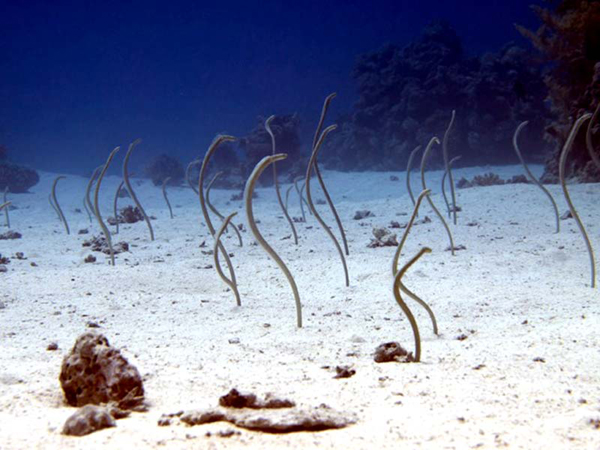
Wedged into his bathysphere, William Beebe descended to a record depth of 3,028 feet in August, 1934. On that dive off Bermuda, he observed marvelous new forms of life; Serpent dragonfishes, Sabre-toothed viperfishes, Scimitar-mouths and other magical names populate his notes of the day. Two years later, the peripatetic naturalist found himself in much shallower water off the tip of Baja California. He didn't need the bathysphere for this research dive, but he did need something that would allow him to spend some time at depth. Self-contained-underwater-breathing-apparatus, or SCUBA, was still a few years away. To survey Baja's seabed, Beebe wore a diving helmet that was tethered to a surface air supply. It was a technique he'd first used in 1925 to view coral reefs in the Galapagos islands, the first trained scientist to do so. The helmet was heavy and awkward to use, but granted him the necessary time to observe astonishing creatures in action, edging science that much closer to understanding reef ecosystems.
In 1938, Beebe's account of the expedition, Zaca Venture, recorded wonder-inducing observations made during his Baja surveys. Of one particular dive he wrote, "Before me, covering the considerable expanse of sand within view, was a garden of eels ...They resembled iron rods as much as anything, slightly bent above the middle of their length, sticking up from the sand, but, unrodlike, swaying very slightly. As I crawled slowly toward them, those nearest me, without effort ... sank gently into the sand, until only the heads were visible. When even the latter disappeared the sand closed over the small holes and the eels were as if they had never been."
Beebe was the first to link what seem to be incongruous words -- garden and eel. But the label is accurate -- and has stuck -- for at a distance, a colony of garden eels appears to be nothing more than a thin field of seagrasses, swaying back and forth before an underwater breeze. Peering down from the surface, the "seagrass" is easily dismissed, and one's eyes move elsewhere in search of more interesting sights.
But submerging to the eel's level is necessary for a better perspective, preferably with scuba gear. Moving nearer to the "seagrass bed," the diver may think she's experiencing a sort of rapture of the deep. Approaching more closely, the seagrasses begins to disappear tail-first until, pffft! they're gone and the only thing left is a sandy flat, seemingly devoid of life. "Oh my, there's some more over there," she thinks and fins in that direction, only to experience the same spectacle. Odder still, there seems to be a sort of wave effect, the grasses in front disappear and those left in the diver's wake reappear! If our diver lets herself sink to the bottom and simply watches for a short time, she will see the seagrass slowly sprout, a time-lapse view of a new plant's emergence. But what plants are these? Plants don't have eyes!
If coral reefs are submerged cities, then Garden eels live in the suburbs, choosing to inhabit sandy flats and slopes adjacent to the reef. They are found in colonies of hundreds, sometimes several thousand, their permanent burrows up to several feet apart. There is safety in these numbers, and as our diver found out, the eels react swiftly, cued by their neighbors to periscope down, tail first, in response to a threat. They are secure from all but the most persistent predators. The Pacific snake eel is one of those. Much larger and more powerful than a Garden eel, the Snake eel burrows into the sand near a colony, digs a tunnel under the eel and grabs its tail. Stingrays are less cunning and use rapid undulations of their powerful fins to dig the eel out. Large Triggerfishes huff and puff at the eel's lair, making a complete mess of things until the creature is exposed.
There are thirty-two species of Garden eels found worldwide, all pencil width and up to twenty inches in length. Their colonies may be seen at depths of around twenty feet, sometimes shallower, but never so deep that it's too dark for them to see their food. They face into the current, feeding on tiny crustaceans known as copepods that drift past. But no matter how tempting it might be to swim after a tasty tidbit, the eels remain anchored to their burrow, never leaving except to establish a new home in order to mate.
An unusual lifestyle like this requires some specialized adaptations. The caudal or tail fin of a Garden eel is modified into a hard fleshy point, which it uses to drive into the sand. As the resulting burrow runs deeper, the eel's dorsal fin comes into play, funneling the sand, auger-like, out of the hole. Cave-ins are averted by cementing the walls of the burrow with slime produced by a gland near the tip of the tail.
As mating season approaches, Garden eel thoughts turn to construction requirements before the sex. Cohabitation in a structure built for one isn't possible, so males and females build new burrows close enough to consummate the act, an entwining ballet performed while each partner remains anchored to home port. Fertilized eggs are released into the current, bound for the open ocean close to the surface. Most eggs and juvenile eels are snapped up by hungry mouths, but a few survive and drift along until large enough to swim down to the seabed, there to tunnel in and begin the cycle anew.
In this Kingdom most of the plants are animals, the fish are friends, colors are unearthly in their shift and delicacy; here miracles become marvels, and marvels recurring wonders.
- William Beebe

01/12/2016
07:30:56 PM